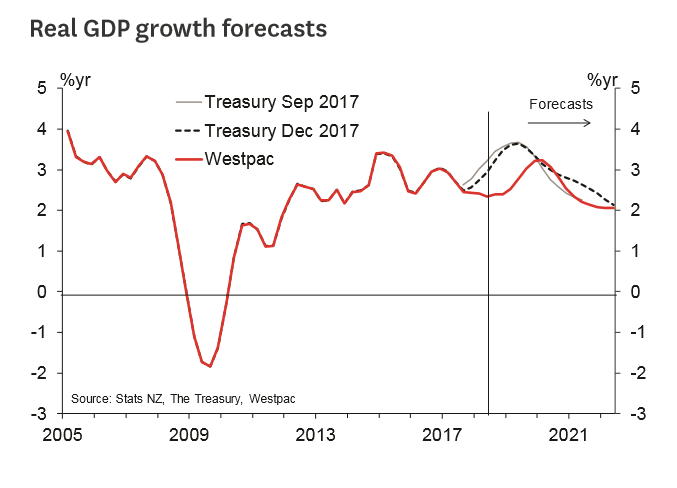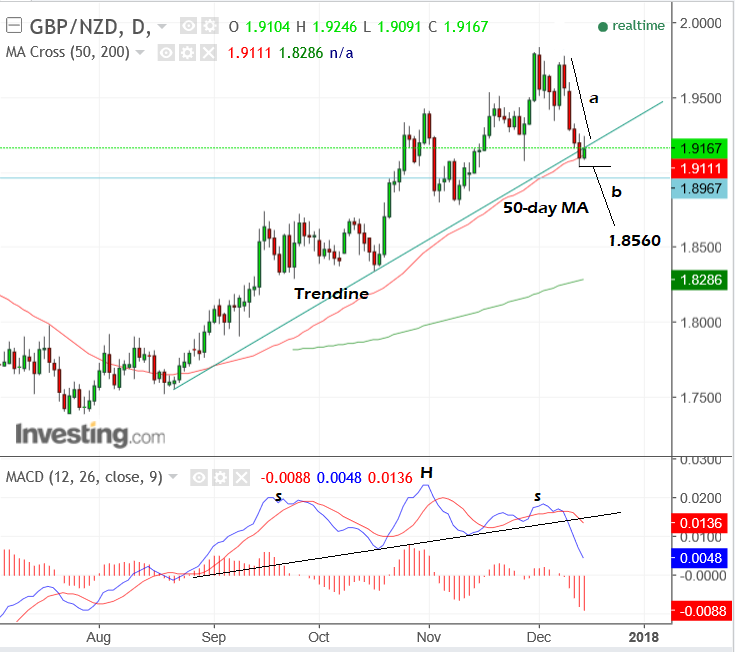Budget Delivers No Joy For New Zealand Dollar; Analysts Pessimistic; Charts Offer Hope

The New Zealand Dollar has weakened after the first budget of the recently elected government, despite generous spending promises, but the charts indicate the currency may yet recover.
The New Zealand Dollar fell against the Pound and Dollar Thursday maiden budget of the Labour-led, and left-leaning, coalition government missed the spot with investors.
Analysts had expected a budget full of potentially growth-boosting public spending programs, which might offset some of the Kiwi-negative rhetoric around trade and reform of the Reserve Bank.
The government didn’t disappoint there, delivering increased spending on social programmes and an extensive affordable-house building program, but “optimistic” forecasts for growth and borrowing may have jilted investors.
In the low growth and low inflation climate of today, increased government spending is seen as a growth-friendly strategy that is more likely to push up inflation and interest rate expectations - good things for currencies.
“We doubt the economy will live up to Treasury’s bullish expectations. If it doesn’t, the tax take may fall short of forecast, leaving the Government with difficult choices,” says Dominick Stephens, chief economist at Westpac.
We can speculate as to other possible reasons for the Kiwi's lacklustre performance Thursday, but two stand out for us, one to do with politics and the other more to do with economics.
The political factor may be to do with the government further tightening its regulation of foreign purchases of New Zealand property.
New Zealand’s government introduced bill in parliament Thursday that will outlaw the acquisition of existing residential homes by overseas buyers.
Foreign buyers will not be able to acquire NZ homes unless they are increasing the number of residences before selling them or changing the land to another use once the bill is passed.
“We expect the law to be passed early next year fulfilling a key pledge in our 100 Day Plan. The previous National government said it couldn’t be done without breaching trade agreements. They just didn’t try and in doing so, they put foreign buyers ahead of New Zealanders,” says Phil Twyford, Labour’s minister for housing and development.
Outlawing foreign purchases of New Zealand property so as to cool rising prices in the housing market and make them more affordable to ordinary New Zealanders was a key pledge from Labour during September’s election.
Get up to 5% more foreign exchange by using a specialist provider by getting closer to the real market rate and avoid the gaping spreads charged by your bank for international payments. Learn more here.
Kiwi a Casualty of Bad Maths?
Labour’s swift move on the ban may have caused some investors concern about the path of other policies relating to trade and foreign investment, which would be negative for the currency. But then again, it could have been just plain old economics.
“The HYEFU includes an additional $8.4bn of operating spending over the next four years, compared to the PreElection Fiscal and Economic Update (PREFU) in August. This largely consists of a $5.5bn Families Package and an additional $2.5bn for tertiary education,” says Stephens at Westpac.
The government claims it will finance its increased spending through higher tax revenues, including by not going through with tax cuts announced by its predecessor, and so it will not need to borrow any more money over the coming years. Based on this idea, the government predicts it will run a substantial budget surplus in five years time.
“That late surge in the surplus plays an important role in the Government’s fiscal responsibility commitments: it brings net core Crown debt down to 19.3% of GDP by June 2022, meeting its goal of reducing net debt to 20% of GDP within five years,” says Stephens. “However, it’s difficult to track where that sharp rise in the surplus comes from.”
Westpac has been consistently bearish the Kiwi and is even more so now. Their G10 currency portfolio was 33% short the currency at one point not long ago (betting it will go down in value).
"We were very surprised by that prognostication," says Michael Gordon, a Senior Economist at Westpac.
Underpinning the Treasury's expectations are assumptions that the economy will continue expanding at its current pace, house prices continue to rise at 2.0% per year, the population continues to grow at present rates and business investment expands at “a brisk pace.”
Westpac's Gordon, however, questions all these assumptions. He argues house prices will be dampened by restrictions on foreign ownership, the population is already slowing in growth, housebuilding will not contribute much to overall GDP and business confidence has been so low recently that investment will almost certainly follow suit.

Above: Chart showing Treasury growth forecasts relative to Westpac growth forecasts.
Get up to 5% more foreign exchange by using a specialist provider by getting closer to the real market rate and avoid the gaping spreads charged by your bank for international payments. Learn more here.
Technical Study Gives Hope to Kiwi Bulls
The chart of the GBP/NZD offers an antidote to the pretty negative fundamental outlook for the New Zealand Dollar.
Technical studies of the Pound-to-New Zealand Dollar suggest that the pair is more likely to fall than rise - which means the Kiwi is more likely to strengthen versus the Pound than vice-versa.
The pair has fallen to - and then pierced just below - a trendline on the daily chart (see below), and this suggests the possibility of a reversal in the trend.
Although the pair appears to have broken below the trendline, and this would ordinarily confirm to a high probability that the pair was going lower, the location of the 50-day moving average at about the current market level of circa 1.9100 is another 'obstacle' for the exchange rate to overcome before it can go lower.
Normally, following a break, the exchange rate would be expected to follow-through lower the same distance (labelled b) as the length of the move prior to the trendline (labelled a).

Above: Chart showing GBP/NZD over the second half of 2017.
This would see the exchange rate reach a downside target at 1.8560. However, the 50-day is a significant obstruction which could act as a spoiler, and we would ideally wish to see a break clearly below the 50-day, confirmed by a move below 1.9035 first before expecting a continuation down to the 1.85 target.
About Moving Averages
Moving averages (MA) tend to block prices on charts because they attract more buying and selling pressure.
This is because traders tend to open extremely short-term trades when prices hit moving averages, trading the pull-back or bounce in a 'scalp' or short-duration swing trade.
In the end, greater demand or supply from these short-term technical traders anticipating a bounce of a pullback off the MA actually propels the pull-back or bounce in a self-fulfilling prophecy.
Another reason prices often bounce, pull-back, stall or reverse at MAs is because large funds and institutional investors often make buy and sell decisions based on where the price is in relation to the 50 or even the 200 MA.
Get up to 5% more foreign exchange by using a specialist provider by getting closer to the real market rate and avoid the gaping spreads charged by your bank for international payments. Learn more here.




